December Comedy:
Studies in Senior Comedy and Other Essays
We were not prepared for the 80 some participants who passed up the Paul Wellstone discussion for humor.
The test itself had two parts, the Humor Quotient Test and a questionnaire about appreciation for four songs by Peter, Paul, and Mary.
The test pits joke types against one another in 42 pairs, half cartoons and half textual, and asks participants to indicate which of the two jokes in the pair they prefer.
The two highest joke preferences indicate a humor personality.
The six humor personalities can be found in literature.
A similar test resulted in correlations between humor personality and preferences for American patriotic songs.
Peter, Paul, and Mary had played on campus when the reunion class was attending Carleton.
Carleton alums have a higher percentage of Crusaders than the Control.
“Blowin’ in the Wind” won hands down as the group’s favorite.
Crusaders like "Blowin' in the Wind." They may be looking for the Holy Grail.
Consolers like "500 Miles."
Reconcilers prefer "Blowin." They may be searching for the unreachable.
Advocates lean toward "If I Had Hammer." Perhaps they want to "hammer out justice."
Bridgebuilders have some desire to have "a Hammer."
Preference for Incongruity humor is related to appreciation of "Blowin' in the Wind."
These findings suggest that our preferences for types of humor are not accidental or arbitrary but rather are rooted in deep concerns and values.
Chapter 14
Humor Preference and Folksong Appreciation:
Peter, Paul, and Mary Return
by Robin and Paul Grawe
Presented at the International Conference of the International Society or Humor Studies
Newport, Rhode Island, 2007
Edited for web publication
About a year ago, my husband and I had the opportunity to administer our humor preference test, the Humor Quotient Test, at Paul’s 40th Carleton College class reunion. Paul had been on the planning committee for the class of 1966, and when the committee started brainstorming program possibilities, we jumped at the chance to extend humor research to another college campus. In addition to furthering our humor understanding, the presentation would spread the word of humor research, provide a venue for discussion of humor’s functions in society, and act as an ice breaker.
Now by class reunion, I’m not referring to a dozen drinking friends getting together for a homecoming game. Carleton alums are a breed of their own. U.S. News and World Report reports that Carleton leads the nation in alumni giving, and according to the president, the college is unparalleled in alumni reunion participation. In fact, I’m told that in 2007 reunion attendance so exceeded dormitory capacity that the more recent grads had to be housed across the river at rival St. Olaf College. Even in 2006 we had reason to hope for a good turn-out. But we were not prepared for the 80 some participants who passed up the Paul Wellstone discussion for humor. About 40 were from the class of ’66, while the others were graduates from other years or were spouses. We had to scramble to help people share tests—but not answers!—with one another.
1
The test itself had two parts, first the Humor Quotient Test, created in the early '90's and administered now to thousands of students and adults and frequently reported on at ISHS conferences; and then a side questionnaire about participants’ appreciation for four songs released by the folk trio, Peter, Paul, and Mary. After all, this was the class of 1966, the Vietnam War era, the civil rights era, the time of the flower child.
We had strong hopes of finding a relationship between humor preference and folksong appreciation. The HQT itself is based in literary criticism and treats its jokes as literary objects with a literary humor structure. So it seemed likely that one literary preference—humor—would be related to another—folk songs.
Briefly the Humor Quotient Test works with what George Meredith called humor of the mind, which he found exhibited in exemplary fashion in Molière and Shakespeare. Humor of the mind is distinct from the easily-recognizable body humor of slapstick, for example, and also from vitalist humor described by Henri Bergson and Suzanne Langer, embodied in joi de vivre and the élan vital. The HQT divides humor of the mind, or what we also call classical humor, into four joke types:
Word Play: we laugh at words combined in a way that clashes.
Incongruity: we laugh at the juxtaposition of seemingly unlike things or ideas.
Gotcha: we laugh when someone thinks he or she is smart, acts on it, and suffers consequences.
Sympathetic Pain: we laugh in sympathy for an undeserving victim.
The test pits joke types against one another in 42 pairs, half cartoons and half textual, and asks participants to indicate which of the two jokes in the pair they prefer. There are no wrong answers. Preference scores for each of the four types are tabulated. An average joke type score is 10.5. Participants almost never score above 19 or below 4 on a particular joke type.
2
From the preference tabulation, we combine the two highest joke preferences to generate a humor personality. Since four items can be paired six ways, there are six humor-derived personalities:
Bridgebuilder, preferring Gotcha and Sympathetic Pain: someone who works with people with sympathy but also a desire to right wrongs
Crusader, preferring Gotcha and Incongruity: someone who perceives problems objectively and works to rectify them.
Advocate, preferring Gotcha and Word Play: someone who uses verbal flair to rectify problems.
Intellectual, preferring Incongruity and Word Play: someone who likes to deal perceptively with facts, words, and ideas.
Reconciler, preferring Sympatric Pain and Incongruity: someone who joins with others in their difficulties for betterment.
Consoler, preferring Sympathetic Pain and Word Play: someone who sympathizes with people in difficulty and soothes the pain by knowing what to say.
While we have labeled these six “humor personalities,” there is really nothing inherently funny in any of them. In fact, they are arguably very serious life roles, revealed by humor preference.
These personalities can also be found in literature. If we analyze the humor patterns in a work of literature or film and combine the two strongest joke types, we can identify a humor personality for that work. Such humor analysis has been the basis for numerous conference presentations. For example, I have argued at other ISHS conferences that Shakespeare’s Henry IV, Part I, dominated by Gotcha and Word Play, is an Advocate play while Steel Magnolias, dominated by Incongruity and Sympathetic pain, is a Reconciler film. Elizabeth Grawe at the Luzo-Hispanic Humor Conference of 1999 argued for an ambiguous humor personality in Don Quijote. The work, unquestionably laced with Incongruity, can be read either as Crusader or as Reconciler depending on whether you stress the Gotcha or the Sympathetic Pain. This ambiguous humor personality helps to explain some of the vexing issues in Cervantes criticism.
3
Paul Grawe, in a 2001 ISHS paper on “Gentle Will” established the prevalent use in Shakespeare’s comedies of Sympathetic Pain humor, heretofore a little-recognized literary humor form, which in Midsummer Night’s Dream teams up with Gotcha to create a Bridgebuilder play and in Comedy of Errors combines with Incongruity for a Reconciler play. The next year at Bertinoro, he delineated the double humor structure of humor of the mind and humor of spirit in Tempest. And in a still later paper, he demonstrated that the Incongruity/Gotcha humor structure of Shakespeare’s Henry V makes Henry a Crusader for the throne of France. The fact that humor analysis can be used to reveal serious life and literary purposes strongly suggests that humor is not fluff, mere comic relief from the truly serious matters of life and dramaturgy. Rather it is part of the real stuff of life and connects to our deepest values.
Given, then, that humor is part of the real stuff of life, it is not surprising that over the last decade and a half, we have found numerous relationships between humor preference and other variables, often mundane variables, ranging from gender and age to safety practices to self-reported use of various forms of critical thinking. Thus we were optimistic that testing for humor preference and folk song appreciation in this earnestly idealistic 1960’s cohort would yield results.
But another reason for our optimism was that we had a model test for humor preference and song appreciation in a 2001 study which found a correlation between students’ humor preference and their appreciation of American patriotic songs. That study, which was reported on in the two issues of the Humor Quotient Newsletter (HQN), was done in the aftermath of the September 11 attack on the World Trade Center. Patriotism was running high, and at the same time columnists were raising the question whether some song other than the “Star-Spangled Banner” would be more appropriate for our national anthem. Ellen Goodman in particular suggested “America the Beautiful” as less bellicose than Francis Scott Key’s work. Of our four joke types, Gotcha was arguably the most bellicose, and a test for correlation between Gotcha humor preference and patriotic song appreciation seemed to hold promise.
4
On the patriotic song side, students were asked to “meditatively read” four patriotic songs—“The Star-Spangled Banner,” “God Bless America,” “America, the Beautiful,” and “Amazing Grace”—and distribute points among the four based on five criteria of appreciation and appropriateness. (See Appendix for full questionnaire.) The study showed a surprising result: participants who liked Gotcha humor did not prefer the “Star-Spangled Banner”; rather they preferred “God Bless America.”
There were a number of other correlations as well, which you can read about in the HQN’s. But this one result was enough to give us hope that if there was a patriotic song-humor connection, there would also be a folk song-humor connection.
We chose to look at Peter, Paul, and Mary primarily because while Paul’s class was attending Carleton the group had performed on campus, to a packed house, of course, and their albums (records then) were played on stereo systems all over campus. Everyone would have some remembrance of their work and also of the times they evoked. So after taking the Humor Quotient Test, participants were asked to recall four Peter, Paul, and Mary songs—“500 Miles,” “If I Had a Hammer,” “Stewball,” and “Blowin’ in the Wind”—and for each of five questions, to distribute 10 points appropriately to the songs. The questions were:
When I remember my time at Carleton, I would most likely remember . . . .
In the ‘60’s, I most liked . . . .
Today, in 2006, I think the best song, aesthetically, was . . . .
I think the song that most typified the mid-60’s was . . . .
I think the song that was most prophetic of our times since graduation was . . . .
(For full questionnaire see Appendix .)
As we digested out results, the first question was Do Carleton grads have a definable sense of humor?
5
We compared useable scores from 63 respondents in all participating Carleton classes to scores from 106 adults in our database tested in non-academic groups in the Upper Midwest. (The control was of similar age and mainly college graduates.) The Table 1 below displays the distribution of humor personalities in each group and the corresponding percentages. Carleton alums have a higher percentage of Crusaders than the Control (p< .01).
Humor Personality Types: Carleton College Alums vs Control
Table 1
We found that a much higher percentage of the Carleton participants scored as Crusaders—33.3%—than the control group—19.8%. Crusaders prefer Gotcha and Incongruity humor. They’re into identifying injustices and working to fix them. I was hardly shocked since in my own years at Carleton (I’m class of ’69), there were numerous student demonstrations, and I remember having to walk through a picket line just to pick up my mail. So it was reassuring, academically, that Carls scored so high as Crusaders and concomitantly so low as Consolers. (Consolers prefer Word Play and Sympathetic Pain and are thus mathematically opposite to Crusaders.) To top it off, the Carleton mascot is the Knight!
For humor preference correlations, we chose to look only at the usable 31 respondents from the Class of ’66, since they shared a similar personal history concerning Peter, Paul, and Mary. Before we get into correlations, some of you might want to know how the four songs fared just in themselves. Not too surprisingly, “Blowin’ in the Wind” won hands down as the group’s favorite. This was, after all, the flower- child era. Our purpose, however, was to find relationships between song preferences and humor preference. And we did find relationships.
6
Plotting participants’ joke preference combinations against their song preference scores, and running a line of regression, we get the following Table. The slope coefficients between humor preference scores and song preference scores can be summarized as follows:
Slope Coefficients for Song Preferences and Humor Personalities
Table 2
Looking first at Crusaders and their mathematical opposites, Consolers, we see that the slope correlation for Crusader is highest for “Blowin’ in the Wind.” That is, the more participants liked the Gotcha/Incongruity combination, the more they appreciated “Blowin’ in the Wind.” (See Chart 1.) The more they liked the Word Play/Sympathetic Pain combination (the Consoler combination), the less they appreciated “Blowin’ in the Wind.” Crusaders are evidently looking for the Holy Grail and know what it means to find the quest blowing in the wind.
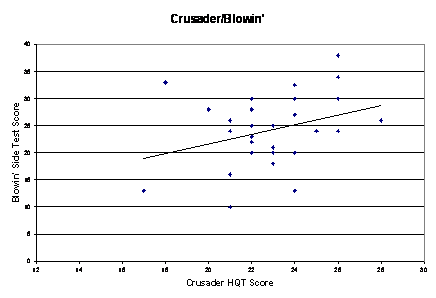

Chart 1
7
The most negative Crusader slope and thus the highest positive Consoler slope is for the correlation with “500 Miles.” ( See Chart 2.) Evidently Consolers can relate to “Not a penny to my name” and “500 miles from my home.”


Chart 2
Looking at the Advocate/Reconciler polarity, the largest negative slope of the table and thus the highest positive Reconciler slope is for “Blowin’ in the Wind.” That is, the more participants like the Incongruity/Sympathetic Pain joke combination (Reconciler), the more they liked “Blowin’ in the Wind.” (See chart 3.) Reconcilers are perhaps like Crusaders in searching for the unreachable or keenly aware of the needs for reconciliation articulated in the folk song.
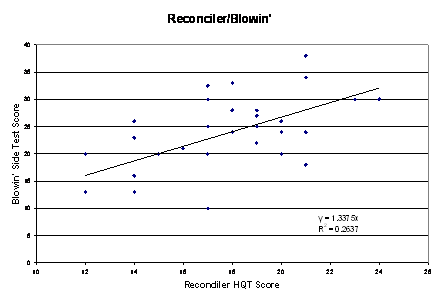

Chart 3
8
The highest Advocate slope is for “If I Had a Hammer,” and that only marginally over “500 Miles.” (See Chart 4) Advocates (who like Gotcha and Word Play) evidently want a hammer to “hammer out justice.” And perhaps they have a desire to close the case, so to speak, and feel that “Blowin’ in the Wind” leaves things up in the air.
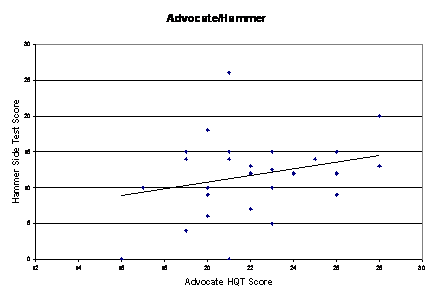

Chart 4
On the Bridgebuilder/Intellectual polarity, participants’ preference for Bridgebuilder humor (Gotcha and Sympathetic Pain), tended to go with appreciation for “If I had a Hammer.” (See Chart 5.) Bridgebuilders seem to like construction. We found several years ago that the Corps of Engineers lockmasters on the Mississippi River had a lot of humor-derived Bridgebuilders. But in the HQT, Bridgebuilders are quintessentially people people, perhaps in this study resonating with all those “brothers and sisters all over this land.”
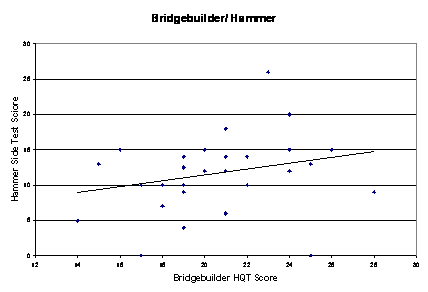

Chart 5
9
The Intellectuals (who prefer Incongruity and Word Play) didn’t buy all that family stuff. The most negative Bridgebuilder slope, and thus the most positive Intellectual slope, was that for “Blowin in the Wind.” However, these preferences are quite weak in comparison to the very strong correlations on the Crusader/Consoler axis.
So summing it up, at the 2006 Carleton College reunion study not only was “Blowin’ in the Wind” the overall favorite of the Peter, Paul, and Mary songs among the class of 1966, it is also most correlated with humor personalities. And specifically it correlates positively with Crusader, Reconciler, and Intellectual. These three humor personalities have in common the analytic preference for Incongruity humor. And in fact, plotting Incongruity preference against Blowin’ in the Wind” appreciation (see Chart 6) yields a positive correlation.
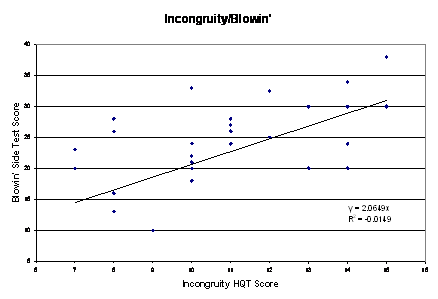

Chart 6
Paul and I would suggest that “Blowin’ in the Wind” as a literary object is a litany of questions concerning life’s incongruities. No one would argue that incongruities are presented as humorous. Yet the song, in challenging us to consider the incongruity between human idealism and historical realities evidently touches the same part of us that responds to Incongruity humor. Humor is not some superficial add-on to our lives but rather related to the real stuff of life. And these findings suggest that our preferences for types of humor are not accidental or arbitrary but rather are rooted in deep concerns and values.
10
Appendix: Side Test Questions
Patriotic Song Questionnaire
In the last generation, four songs have held a special place in American thought. In the following questions, we would like your preferences among these four. To do so, we ask that you divide ten points for each question among the four songs. Thus, for some hypothetical respondent and questions, the four answers might read:
3 2 2 3 (the total of the four weightings being 10).
At a football game, baseball game, or other sporting even, I’d like to sing
Star-Spangled Banner ___ America the Beautiful ___
God Bless America ___ Amazing Grace ___
At a solemn national observance, I’d like to sing
Star-Spangled Banner ___ America the Beautiful ___
God Bless America ___ Amazing Grace ___
In order to embody the spirit of America, I prefer
Star-Spangled Banner ___ America the Beautiful ___
God Bless America ___ Amazing Grace ___
During war time, I think the United States should depend upon
Star-Spangled Banner ___ America the Beautiful ___
God Bless America ___ Amazing Grace ___
In considering their own blessings and responsibilities, Americans should look to
Star-Spangled Banner ___ America the Beautiful ___
God Bless America ___ Amazing Grace ___
© Paul H. Grawe 2001
11
Peter, Paul, and Mary Questionnaire
The Class of ’66 got to see Peter, Paul and Mary live in Skinner Chapel. Please think back and remember:
500 Miles: “Not a shirt on my back, not a penny to my name . . . .”
If I Had a Hammer: “I’d ring it in the morning. . . all over this land”
Stewball: “Stewball was a race horse, and I wish he were mine. . . .”
Blowin’ in the Wind: “How many times must a man turn his head and pretend that he just doesn’t see?”
For this comparison study to your Humor Quotient Test Score, please remember these songs wistfully from our shared Carleton past, then answer the following questions.
For each question, you have 10 point which you can divide in any way you would like among the four songs listed above.
1. When I remember my time at Carleton, I would most likely remember:
500 Miles ____ If I Had a Hammer ____ Stewball ____ Blowin’ in the Wind ____
2. In the ‘60’s, I most liked
500 Miles ____ If I Had a Hammer ____ Stewball ____ Blowin’ in the Wind ____
3. Today, in 2006 I think the best song, aesthetically, was:
500 Miles ____ If I Had a Hammer ____ Stewball ____ Blowin’ in the Wind ____
4. I think the song that most typified the mid-60’s was:
500 Miles ____ If I Had a Hammer ____ Stewball ____ Blowin’ in the Wind ____
5. I think the song that was most prophetic of our times since graduation was:
500 Miles ____ If I Had a Hammer ____ Stewball ____ Blowin’ in the Wind ____
Separate questions: Remember Early in the Morning: “about the break of day, I asked the Lord ‘Help me find the way.’”? Where would you rank Early in the Morning compared to the four songs listed above, 1 being highest, 5 being least in your estimation.
______
My other folk favorites were: _____________________________________________
12
DC Contents DC Cover ITCHS Home

